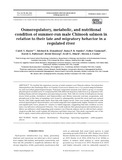| dc.contributor.author | Hasler, Caleb T. | |
| dc.contributor.author | Donaldson, Michael R. | |
| dc.contributor.author | Sunder, Rana P. B. | |
| dc.contributor.author | Guimond, Esther | |
| dc.contributor.author | Patterson, David A. | |
| dc.contributor.author | Mossop, Brent | |
| dc.contributor.author | Hinch, Scott G. | |
| dc.contributor.author | Cooke, Steven J. | |
| dc.date.accessioned | 2020-06-08T19:48:27Z | |
| dc.date.available | 2020-06-08T19:48:27Z | |
| dc.date.issued | 2011-06-01 | |
| dc.identifier.citation | Hasler, Caleb T., Michael R. Donaldson, Rana P. B. Sunder, Esther Guimond, David A. Patterson, Brent Mossop, Scott G. Hinch, and Steven J. Cooke. "Osmoregulatory, metabolic and nutritional condition of summer-run male Chinook salmon in relation to their fate and migratory behavior in a regulated river." Endangered Species Research 14 (2011): 79-89. DOI: https://doi.org/10.3354/esr00343. | en_US |
| dc.identifier.issn | 1863-5407 | |
| dc.identifier.uri | http://hdl.handle.net/10680/1811 | |
| dc.description.abstract | We studied the migratory success of male summer-run Chinook salmon Oncorhynchus
tshawytscha in the Puntledge River on Canada’s Vancouver Island over a 3 yr period using biotelemetry and non-lethal physiological biopsy. Principal component analysis was used to group co-varying physiological variables prior to comparing fish with different migratory behaviors (e.g. migration rate, holding times) and fate (migration and spawning success). Fish with low levels of endogenous energy stores (total protein, cholesterol, and triglycerides) and dietary minerals (calcium, magnesium, and phosphorus) at the time of sampling were found to subsequently ascend the most upstream natural barrier (Nib Falls) significantly faster than fish with higher levels. Fate was weakly associated with several physiological characteristics; successful migrants had significantly higher hematocrit values and significantly lower plasma K+ relative to failed migrants, suggesting that fish condition at river entry can influence subsequent behavior. Our results indicate that physiological and nutritional condition can influence adult migrating male summer-run Chinook salmon, but we did not find a physiological profile that could explain all behaviors and fates observed. This study represents one of the first to apply conservation physiology tools to study an imperiled river fish population. | en_US |
| dc.description.sponsorship | "Funding for this project was provided by BC Hydro’s Water Use Planning, and the DFO Environmental Watch Program. C.T.H. and M.R.D. were each supported by an Alexander Graham Bell Canada Graduate Scholarship from NSERC." | en_US |
| dc.language.iso | en | en_US |
| dc.publisher | Inter-Research | en_US |
| dc.rights | info:eu-repo/semantics/openAccess | en_US |
| dc.subject | Pacific salmon | en_US |
| dc.subject | Biotelemetry | en_US |
| dc.subject | Physiology | en_US |
| dc.subject | Spawning migration | en_US |
| dc.subject | Anthropogenic effects | en_US |
| dc.title | Osmoregulatory, metabolic and nutritional condition of summer-run male Chinook salmon in relation to their fate and migratory behavior in a regulated river | en_US |
| dc.type | Article | en_US |
| dc.rights.license | Creative Commons by Attribution (CC-BY) Licence | en_US |

